 |
Focus features two in-depth reviews each month of fine art, architecture, and design exhibitions at art museums, galleries, and alternative spaces around Japan. |
|
|
 |
 |
 |
Pi and Perspective: Tsuyoshi Hisakado's Practice of Spiral
Jennifer Pastore |
 |
Tsuyoshi Hisakado is a talented engineer of ambiance, but this is not the main purpose of his work. More than what lies on the surface, he interests himself in what's at the heart of things -- the hidden laws and spontaneous occurrences that shape the universe. For instance, Practice of Spiral, his first major solo show in Japan, is preoccupied with Pi, the symbol of constancy and irrationality that orders the cosmos. Now on view at the Toyota Municipal Museum of Art in Aichi Prefecture, the exhibition recently reopened after a lengthy closure due to the coronavirus outbreak.
The title of the exhibition is a reference to Hisakado's interest in perception, specifically how a spiral, when viewed directly from above, can appear as a circle. This way of thinking is at the heart of his practice. Having studied sculpture in university, he learned to seek out the multidimensional potential of all objects. Now his work encompasses everything from solid objects to the soundscapes he calls "disappearing sculptures." Practice of Spiral introduces a full range of his works, filling nine galleries meant to be proceeded through on a spiral-like path. The airy and expansive rooms of concrete, glass, and polished wood take up a total of 1,000 square meters, which could easily dwarf Hisakado's works if they did not expand to fill the space by engaging multiple senses.
 |
|
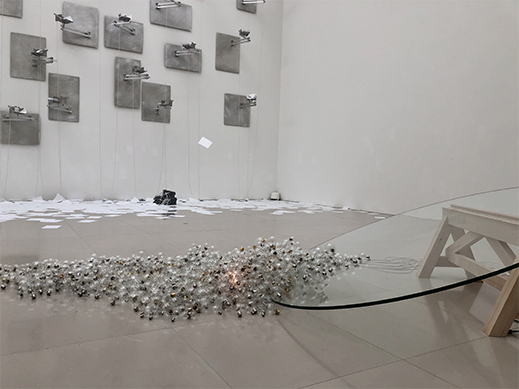 |
|
Installation view and detail, Force (2020). © Tsuyoshi Hisakado |
The first gallery draws on sound as well as sight. Force (2020) is a three-part installation spanning a gallery with a floor area of almost 300 square meters and nearly ten meters high. Attached to the far wall are dozens of aluminum devices -- what look like printing trays. Sheets of white paper flutter down from them, covering the floor. In front of this display is a glass circle tipped on its side, surrounded by light bulbs that glow off and on. Pink noise like rolling thunder emanates from speakers. Taken in its whole, the scene seems like a natural phenomenon. We wonder, "What is happening here? What is the relationship between the papers falling like snow, the flashes of light, the peals of sound? Is one thing causing another?" There are no obvious answers, but as with so many of Hisakado's installations, we are left to contemplate the beauty of the environment and the seeming spontaneity of its happenings. This is a world of heightened awareness and unforeseen consequences.
|
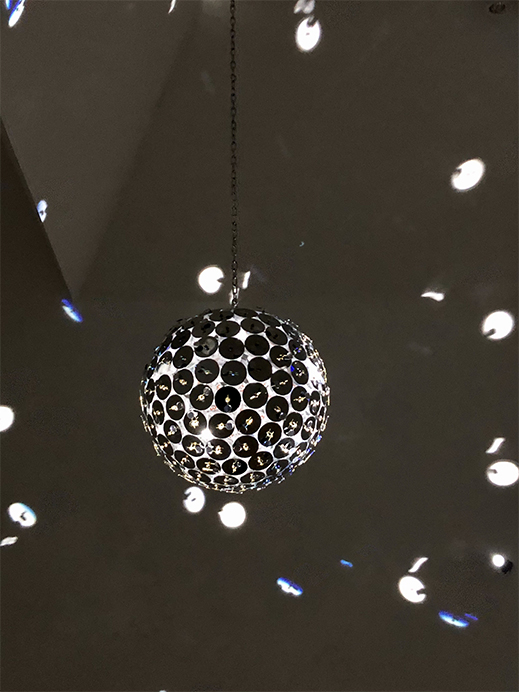 |
|
|
|
After that. (2013/2020), an installation of mirrors, clocks, and LED spotlights. © Tsuyoshi Hisakado
|
After that. (2013/2020) is another immersive realm. Originally created for the Aomori Contemporary Art Centre, it is presented here again in a darkened room with a reflective mirrorball at its center. The ball is covered in small glass clocks with ticking second hands. Light shines from all directions on the rotating sphere, scattering reflections of the clocks across the floor, walls, and ceiling. It is a strange temporal disco. We are reminded of how, while our lives have their individual timelines, we also exist in aggregate like the clocks on the mirrorball. The reflections suggest the possibility of something out beyond this world we know.
|
Tsuyoshi Hisakado speaks in front of A Polite Existence - Present Location (2020). © Tsuyoshi Hisakado
|
|
A Polite Existence - Tunnel (2020). © Tsuyoshi Hisakado |
A Polite Existence is a new series of six vitrine-like glass and wood sculptures, each with its own attributes. These pieces are arranged throughout a gallery filled with natural light. Exhibition materials explain that the series title in Japanese (Teinei ni Ikiru) means "to steadily age while making the most of one's daily experiences and accumulated knowledge, and for this very reason it means one is also capable of dealing with events that occur unexpectedly." The work A Polite Existence - Present Location (2020) resembles the model of a multilevel condominium with small cubes placed in separate "rooms." As Hisakado remarked at the exhibition's pre-opening event, with this work he is alluding to the stratified nature of society and our individual places within it while living as a collective. A Polite Existence - Earthquake (2020) is a split vitrine with one side propped up by sandbags, a reminder of the unexpected occurrences and consequences of natural disasters. A Polite Existence - Tunnel (2020) returns to the artist's fondness for movement and circular motifs. A round shape cut into the glass revolves inside and outside the pane, suggesting the variable -- or perhaps artificial -- nature of distinctions and borders.
|
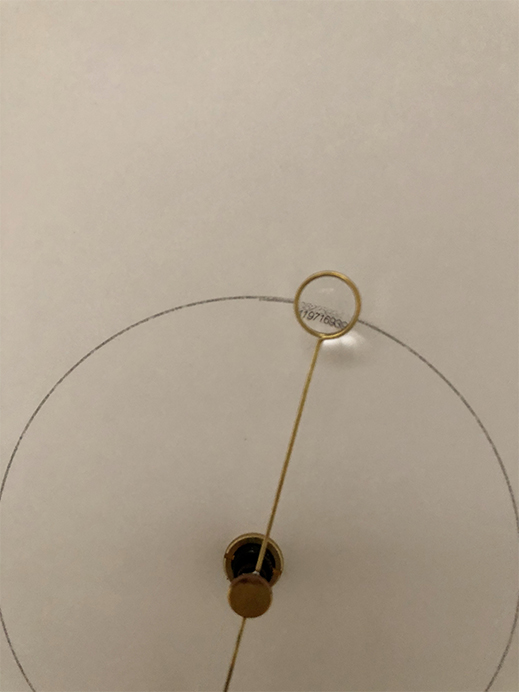 |
|
|
|
crossfades #1 (2015/2020). © Tsuyoshi Hisakado
|
Occupying an all-white gallery almost entirely by itself is crossfades #1 (2015/2020), an installation of what appears to be a small circle drawn onto the wall. Around it a slender metallic arm ticks clockwise, its outer end extending into a tiny magnifying loupe. Peering through the loupe, we see a series of miniscule numbers that turn out to be the digits of Pi. It is a marvel to behold, filled with the wonder of discovering something that has been there all along.
Part of a series (left) and detail (right), crossfades #4 (2020). © Tsuyoshi Hisakado |
Hisakado closes out the show with the Pi motif in crossfades #4 (2020), a series of 29 screenprints on paper with the numerals of Pi printed in spiral patterns. Each work requires the viewer to come up close to see the numbers, and surveying the prints, we realize Hisakado has reshaped the spirals by a variety of methods. In some cases he has cut the papers into pieces, or reshuffled the digits, overlapped them, dissolved the ink, or let it run. Once again Pi is revealed to us in fresh ways, presenting what the museum calls "the relationship between series of unpredictable events and the hidden code operating behind them."
Hisakado is said to be fond of this quote by the 12th-century Buddhist poet Kamo no Chomei: "The flowing river never stops and yet the water never stays the same." We see this principle in many of his atmospheric installations of objects and sound, in which computers generate sequences of noise that never occur twice. This composed spontaneity is a key element in his series Quantize (2014), which is revisited with a new installation in this show. Kamo no Chomei's notion of ceaseless change is of course also evident in Pi, with its seemingly endless stream of digits that do not repeat. Time and again, Hisakado returns us to the mundane and mysterious aspects of existence, attuning us to what is both constant and revelatory.
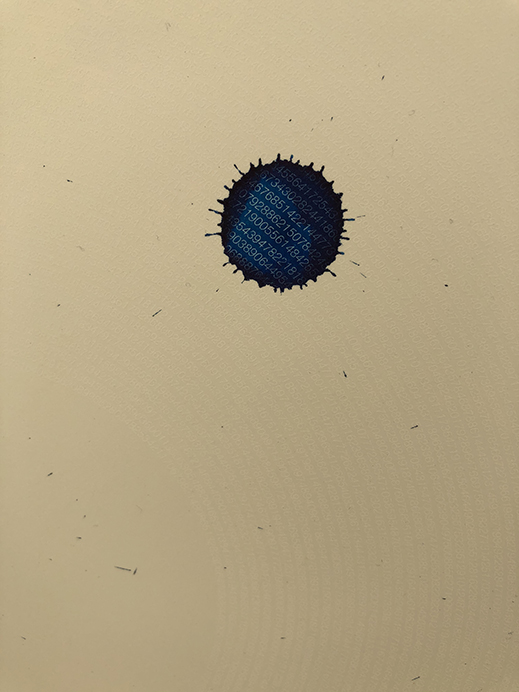 |
|
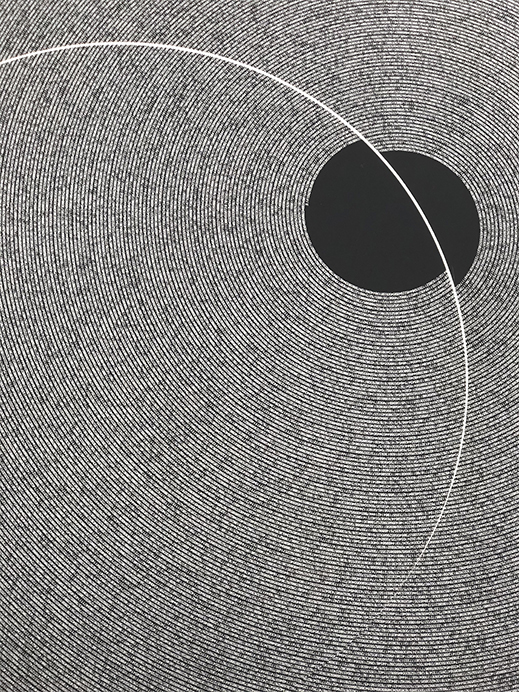 |
|
|
|
Two prints from the series crossfades #4 (2020). © Tsuyoshi Hisakado |
All works shown are by Tsuyoshi Hisakado. All photos are by Jennifer Pastore, by permission of the Toyota Municipal Museum of Art. |
 |
 |
Jennifer Pastore
Jennifer Pastore is a Tokyo-based art fan and translator. In addition to Artscape Japan, her words have appeared in ArtAsia Pacific, Sotheby's, and other publications. She is an editor at Tokyo Art Beat. |
|
 |
|